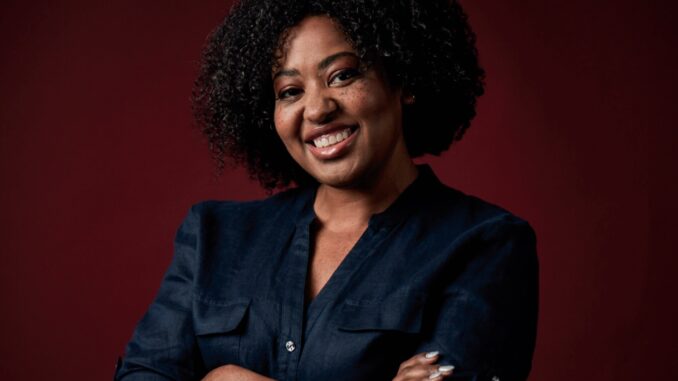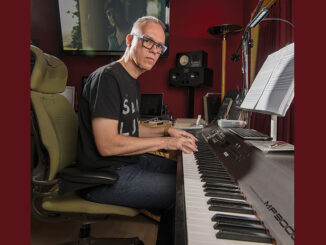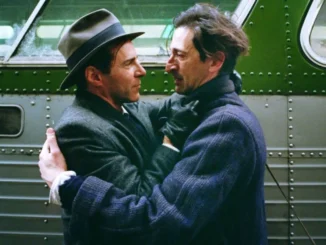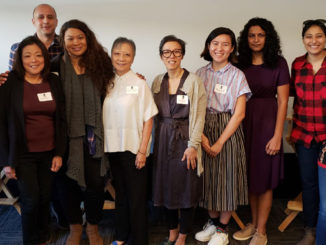
Shannon Baker Davis, ACE, has come a long way from Georgia.
The picture editor moved to Hollywood after college and honed her skills in television (“Grown-ish” and “Queen Sugar”).
Her latest project, “The Photograph,” Universal’s new romance drama starring Issa Rae (of HBO’s comedy “Insecure”) and Lakeith Stanfield, is in theaters on February 14.
She spoke with CineMontage about growing up with scientist parents, her love of “Pulp Fiction,” and the importance of balancing work and family.
Q How did you get involved in “The Photograph”? What were your reactions to the script?
I had worked with the director, Stella Meghie, on two previous projects, “Grown-ish” and an indie film called “The Weekend.” We clicked from the first day, and, when she mentioned that she had a feature in development at Universal, I was interested, even before reading the script, based on how great it was working with Stella, and based on seeing and loving her first film, “Jean of the Joneses.” When I got the script, I connected with it immediately because I had grown up watching and re-watching black romances like “Love Jones” and “Love and Basketball,” and “The Photograph” tapped into that feeling I hadn’t felt in a while. The script also took relationships to the next level by including a mother-daughter story that was so heart-wrenching.
Q What was your working relationship like with the director? How often was she in the room? Does she give you a lot of notes leading up to editor’s assembly, or just let you fly solo until later?
Since this was our third project together, I knew what Stella liked and disliked. And I think she has a trust that my instincts will line up with her intentions. She doesn’t usually do a lot of takes, and I can always pick up on the adjustments in the dailies. It’s almost like she’s communicating through takes just on account of the changes in performance. I was pretty much free to try things (after putting together the script, of course). Then we worked together in the room daily to get it to directors cut and then to picture lock. I think the fun of working with a director is the talks. I’m a talker. I like to talk through things. And when you work with a director who has a precise vision and specific taste, who can have a discussion about it, it helps the project evolve into what it needs to be. Just like any personal relationship, a movie gets hard to make when the communication shuts down.
Q You mentioned working together previously on “The Weekend.” What was that experience like? Did it help when approaching “The Photograph” that you two had a previous work collaboration?
“The Weekend” was a scrappy little movie that was super personal to Stella and became my first big festival film, when we premiered at Toronto Film Festival. I’m really proud of it. Post was a hyper-speed super-short six weeks. And I think we actually got to a cut that we started showing people after three weeks. I loved “The Weekend” because the comedy was so fresh and new and the jokes were cutting and different. Zadie’s character is just so wrong and so right at the same time. And it’s also nice to see black people in a romantic comedy not set in the typical places we see ourselves. It’s set at a bed-and-breakfast in the middle of nowhere. Black people hiking!
Working on “The Weekend” was pretty much a teaser for “The Photograph.” It was indie, so we got a lot of freedom to try whatever we wanted and be creative; to take chances and not be afraid of taking chances. So when we were working on a studio film with a much bigger budget, we had worked out a shorthand and already knew each others’ tastes. So when the tastes of the studio, which represents a much larger audience, came into play, we could adjust to that together, knowing we were already on the same page.
Q What were the hardest parts of cutting “The Photograph”? What was tougher than expected? Was it a specific scene? If so, what made it difficult?
Cutting a studio film is next level! I had never experienced the rounds of critique and having to navigate preview screenings and marketing and being on location, and the always lingering fact that we held the responsibility of a much bigger budget. On this project more than others, I saw how as an editor, there’s so much history to a project that happens before you even touch the footage. To understand that the process may end with you, but didn’t begin with you, is eye-opening and becomes a huge responsibility. Frankly, I didn’t know what to expect. I learned so much about the process when it comes to a studio film. Sometimes I felt like I was faking my way through things. Then when it felt like a whirlwind, I basically took refuge in knowing no matter what, I’m a good editor and I have good instincts. I could always adjust but I knew I just needed to do what feels right.
As far as specific scenes, we really worked and reworked the opening, about the first 12 minutes of the movie. We did so many versions of the opening because we knew we had to get it right. And we have intertwining stories in the past and present so putting those stories together is like working a puzzle, a puzzle where you’ve lost the box top and you have no idea what the final picture is supposed to be. There’s a point when the structure, sort of locks into place, and no one on the outside can tell you where that place is. You have to push yourself to find it.
Q Looking back, what parts of the film are you most proud of?
I’m most proud of making a simple story feel heavy and emotional. Even if you don’t have these specific situations or types of people in your own life, the emotion is there and anyone and everyone can grab onto something in the movie. I hope it grabs onto audiences. Who doesn’t want to feel love, and especially on Valentine’s Day!
When you make something, you never know if people will like it as much as you do. You hope they do, but you never know. When the first trailer was released on the Internet, people went crazy over the movie, and I think it’s because there hasn’t been a movie like this in a wide release, starring people that look like this, in a long, long time. I’m really proud of being a part of something that people like me, who grew up with great black love stories, are excited to finally see again.
Q What made you want to become an editor? What process brought you to this point?
I always knew I wanted to do something in television or film. But growing up in Augusta, GA, with parents who were scientists and just wanted me to get a good paying job working for somebody, I had no clue and no access to that career path. I didn’t even know that movies were “edited.”
When I saw “Pulp Fiction” in high school, I think that was the movie that made me aware that a movie was “put together.” I went to undergrad at Howard University for Radio-TV-Film and quickly got a job at a post house that cut political ads and Time-Life infomercials. I learned the Avid on that job and watched the editors’ process. But I decided I didn’t want to stay in the advertising field. So I went to graduate school at the American Film Institute, and that’s where I learned the craft of narrative editing.
When I graduated from AFI, I had the knowledge but still no access, so I moved to NY and got into reality TV editing. I moved up pretty quickly because I had learned and been basically drilled on storytelling at AFI. Fast-forward 10 years, and I decided I wanted to get back to my first love, scripted editing. With the help of some editors who stuck their necks out for me to give me a shot, I was able to get a job assistant editing on “The Good Wife,” “Insecure” and “Nashville” and then I worked my way back to editing. Cut a couple TV series, one of which was “Grown-ish,” and that’s how I met Stella, and the rest is history.
Q Many editors speak of the difficulty of balancing work and home life. How has this been brought home to you? What was that like working on “Photograph”?
It’s not so hard. Just kidding! It’s hands-down the hardest part of adulting, and I’m still trying to figure it out! I am a hard worker, and I like to think I’ve become an efficient editor. I have to be! When you have young kids and a husband and parents and friends whose faces you want to see as much as possible, you absolutely cannot have wasted time in your days. I also like to think I help the projects I work on by getting the work done in the least wasteful way. Having kids has also taught me to think ahead to plan B, C and D, because with kids, Plan A is usually a pipe dream. My life seems like it’s a constant pivot. So it’s helpful when you have to re-imagine something for a film or show or whatever you’re cutting.
I had to go on location in New York for “The Photograph,” and that was the toughest decision I think I had to make. Just ask all the many, many people I went to for advice when I was trying to decide whether I should go. I asked so many people what I should do, and not one person said, “Don’t go.” And I’m so glad I listened.
My husband was so great and supportive, too. At one point when I was waiting on the go-ahead to be hired from the studio, he told me, “If you get this, you have to take it. We’ll figure it out.” And when he said that I felt okay with the challenge I knew we would have in front of us. My son was barely three months old when we left for New York, the week before production started. My son and I stayed in New York the entire eight months, and my husband and our five year-old daughter came for a couple months over the summer. Being split was tough, but judging from what little sleep I got with one kid, I might’ve had a meltdown if I’d had to share myself with two. But what also ended up happening is my daughter got to spend a summer in NY, and I’m so happy I was able to show her the city.
I think one of the keys to balancing is to also have a director that gets that family is a big chunk on my personal pie chart. Stella was super-supportive. I was breastfeeding, and she never once made me feel bad when I had to stop to pump. Little things like that make a huge difference. I don’t know if it’s a woman thing, but the women on our post staff (an all-woman post staff by the way) were all super supportive.
I’m a nurturer by nature, so it was nice to feel like my home life was being “cared for” by the people I was working with. The post execs at Universal (who were male, so maybe it’s not a woman thing) were also supportive. I gave them a few “asks” that I thought I would absolutely not get, and was pleasantly surprised when they found a way to make it happen. I’m learning that you MUST ask for help.
Looking back on the journey, I’m so glad I did it. Working on “The Photograph” turned out to be so fun, so rewarding, and such a career high for me. Don’t get me wrong, it was A LOT of work, but I can honestly say it was all worth it, and with everything I’ve learned, I can’t wait to dive into the edit again.





